
Juncaceae is a family of flowering plants, commonly known as the rush family. It consists of 8 genera and about 464 known species of slow-growing, rhizomatous, herbaceous monocotyledonous plants that may superficially resemble grasses and sedges. They often grow on infertile soils in a wide range of moisture conditions. The best-known and largest genus is Juncus. Most of the Juncus species grow exclusively in wetland habitats. A few rushes, such as Juncus bufonius are annuals, but most are perennials.

Juncus is a genus of monocotyledonous flowering plants, commonly known as rushes. It is the largest genus in the family Juncaceae, containing around 300 species.

Juncus effusus is a perennial herbaceous flowering plant species in the rush family Juncaceae, with the common names common rush or soft rush. In North America, the common name soft rush also refers to Juncus interior.

Juncus balticus is a species of rush known by the common name Baltic rush. It is a perennial flowering plant in the family Juncaceae. It can reach a height of about 75 centimetres. It is native to north-western Europe from Spain to northern European Russia, most of North America except the south-eastern United States, parts of Mexico and Central America, and western and southern South America from Colombia to Argentina. It is available from specialist nurseries for landscaping and soil stabilization purposes.

Juncus acutiflorus, also called sharp-flowered rush, is a rush or a grassy flowering plant in the family Juncaceae. As the name suggests, the plant has notable sharp-looking flowers, flowering between July and September.

Juncus antarcticus, also known as dwarf rush, is a flowering plant species in the rush family Juncaceae, native to New Zealand and Australia.

Juncus bulbosus, the bulbous rush, is a species of flowering plant in the family Juncaceae, native to Iceland, the Faroes, Europe, Macaronesia, and northwest Africa. It has been introduced to Australia, New Zealand, and some locations in northern North America. It is capable of nuisance growth in lakes and streams.

Juncus inflexus, the hard rush, is a species of flowering plant in the family Juncaceae, native to Europe, Asia and Africa, and introduced in Sri Lanka, Java, Île Amsterdam and Île Saint-Paul, Victoria in Australia, New Zealand, Uruguay, and eastern North America. It is a glycophyte (non-halophyte).
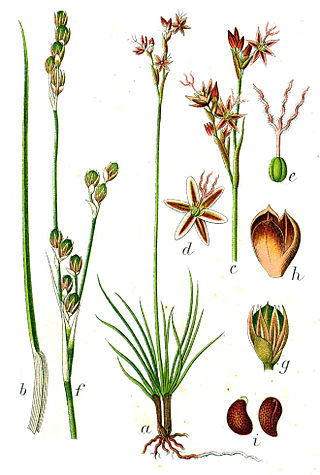
Juncus squarrosus, called goose corn, heath rush, and mosquito rush, is a species of flowering plant in the family Juncaceae, native to Iceland, Europe, and Morocco, and introduced to Greenland, Svalbard, Tasmania, New Zealand, and the US state of Wisconsin. It is pollution-tolerant.
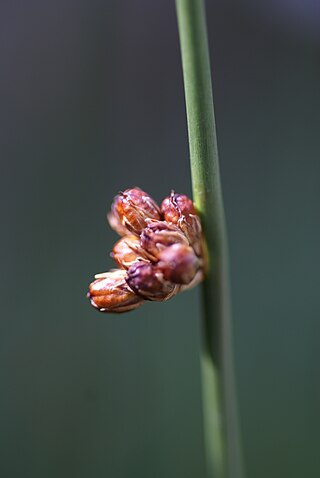
Juncus arcticus, called the arctic rush, is a species of flowering plant in the family Juncaceae, native to the subarctic and subalpine northern hemisphere. It is typically found in wetland and riparian habitats.

Juncus triglumis, called the three-flowered rush, is a species of flowering plant in the genus Juncus, native to the subarctic and subalpine Northern Hemisphere. It is typically found in calcareous tundra habitats and arcto-alpine fens. It is often found in association with Carex atrofusca and Carex bicolor in the so-called Caricion bicolori-atrofuscae alliance.

Oreojuncus is a small genus of flowering plants in the rush family Juncaceae, found in the eastern United States, eastern Canada, Greenland, Iceland, the Faroes, most of Europe, northern Russia, western Siberia and the Altai. Their chromosome number is 2n=30 (x=15), whereas Juncus, from which they were split, has x=20.

Juncus scirpoides, the needlepod rush, is a species of flowering plant in the family Juncaceae, native to the central and eastern United States. It prefers wet sandy soils, and among the many places it grows it is common in the enigmatic Carolina bays.
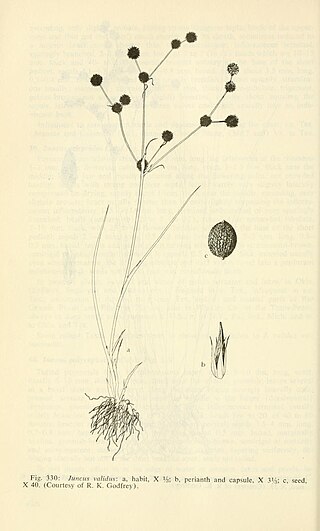
Juncus validus, the roundhead rush, is a species of flowering plant in the family Juncaceae, native to the central and southeastern United States. It is a somewhat weedy species, found along wet roadsides and in ditches.
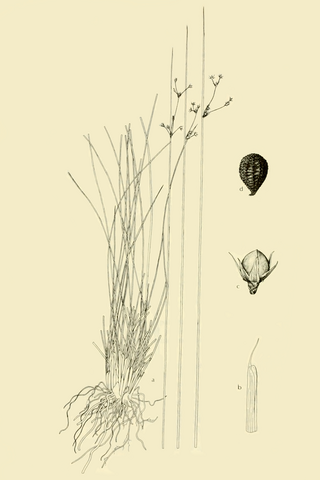
Juncus coriaceus, the leathery rush, is a species of flowering plant in the family Juncaceae, native to the southeastern United States, from Texas to Cape May, New Jersey. A report from New York state turns out to have been erroneous. A wetland species, it prefers poorly drained soils.

Juncus caespiticius, the grassy rush, is a species of flowering plant in the family Juncaceae, native to coastal areas of southern Australia and New Zealand. It usually grows in cool damp areas, preferring fresh or slightly brackish water.
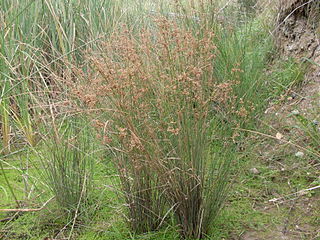
Juncus usitatus, the common rush, is a species of flowering plant in the rush family, Juncaceae. A graceful, clumping plant growing from 40 cm to 1.1 metres high. Commonly found in New Zealand and eastern Australia in disturbed sites by stream banks and other moist habitats. The specific epithet is derived from Latin, meaning "common or usual".
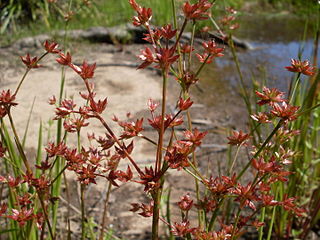
Juncus prismatocarpus, the branching rush, is a tufted, perennial species of flowering plant in the rush family, Juncaceae. Found in moist situations, often on sandy ground. Grass-like leaves are 10 to 40 cm long, 1.3 to 3.0 mm in diameter. It grows in many parts of Australia, New Zealand and south east Asia. The specific epithet is derived from Latin, meaning prism-shaped fruit.
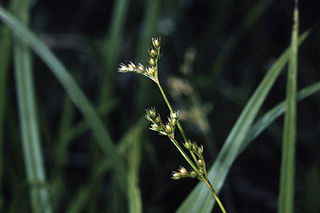
Juncus secundus, the lopsided rush, one-sided rush, or second rush, is a species of flowering plant in the family Juncaceae, native to eastern North America and introduced to Primorsky Krai in Russia. It is typically found in serpentine, granite, and other barrens.
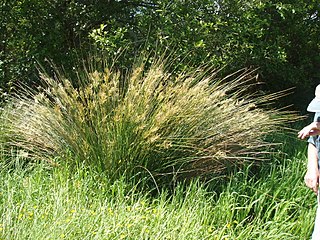
Juncus sarophorus, the broom rush or fan-flowered rush, is a species of flowering plant in the family Juncaceae. Native to southeastern Australia, and all of New Zealand except the Kermadec Islands, it also has been introduced to Great Britain. A dense tussock-forming perennial of wet areas, and somewhat weedy, its stems reach 2 m (6 ft) long but droop so that the plant overall is closer to 1 m (3 ft) tall.


















